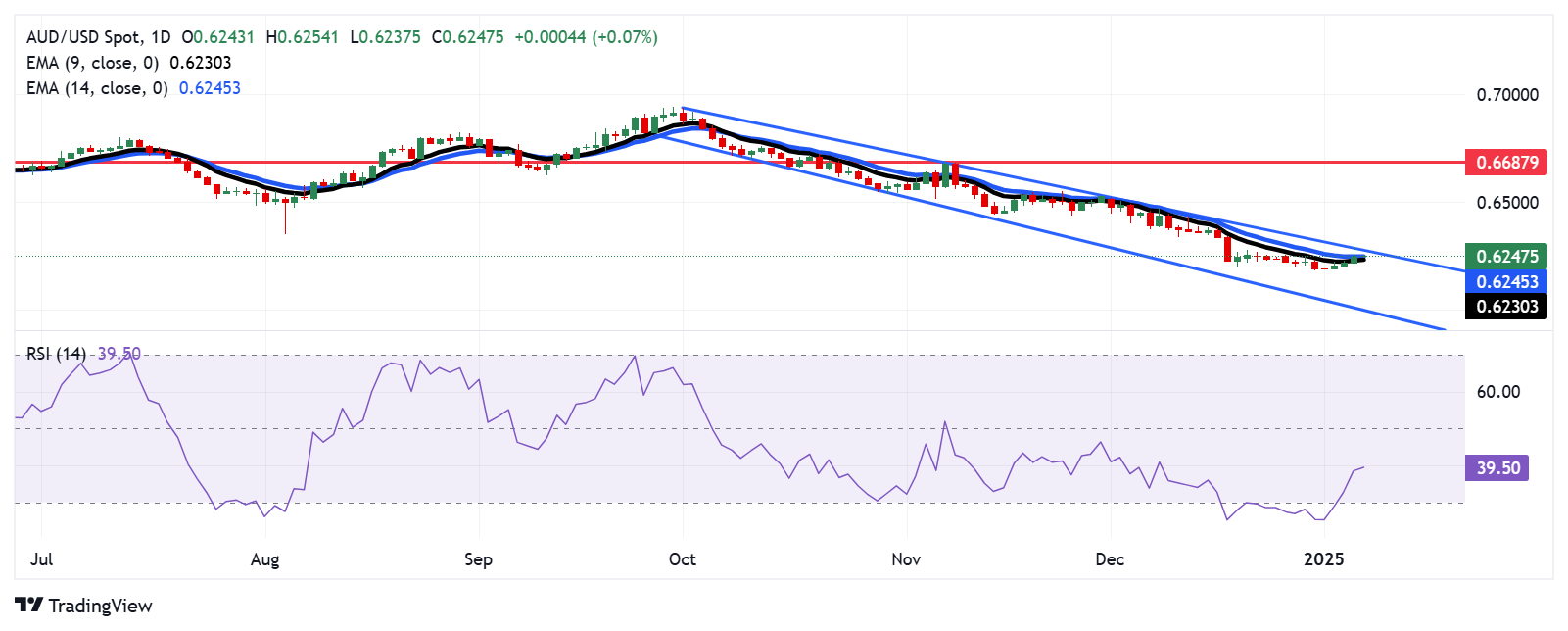- The Australian Dollar remains strong following the Building Permits data release on Tuesday.
- Australia’s seasonally adjusted estimate for total dwellings approved decreased by 3.6% month-on-month to 14,998 units in November 2024.
- Traders await the release of the US ISM Services PMI later in the North American session.
The Australian Dollar (AUD) gains ground for the fourth consecutive session against the US Dollar (USD) on Tuesday. The AUD/USD remains stronger despite weaker-than-expected Building Permits for November. US ISM Services Purchasing Managers Index (PMI) is set to be released later in the day. On Wednesday, markets will focus on the Minutes from the Federal Reserve's (Fed) December policy meeting.
The permits for new construction projects in Australia dropped by 3.6% month-on-month to 14,998 units in November 2024, falling short of market expectations for a 1.0% decline. This downturn followed an upwardly revised 5.2% increase in October, marking the first decrease in three months.
Australia’s Monthly Consumer Price Index (CPI) for November, scheduled for Wednesday, will be in the spotlight. If the reading comes in below market expectations, this could trigger the chance of a rate cut by the Reserve Bank of Australia (RBA) at its February meeting, weighing on the AUD.
Officials from the People's Bank of China (PBoC), the National Development and Reform Commission (NDRC), and the Ministry of Finance (MoF) will hold a briefing on Wednesday to discuss the expansion of the consumer goods trade-in program.
Australian Dollar rises despite a hawkish shift in Fed’s policy outlook
- The US Dollar Index (DXY), which measures the US Dollar’s (USD) performance against six major currencies, edges higher to near 108.00 at the time of writing.
- The US ISM Manufacturing PMI improved to 49.3 in December, from 48.4 in November. This reading came in better than the market expectation of 48.4.
- Richmond Fed President Thomas Barkin highlighted on Friday that the benchmark policy rate should remain restrictive until there is greater confidence that inflation is on track to return to the 2% target.
- Fed Governor Adriana Kugler and San Francisco Fed President Mary Daly underscored the challenging balancing act facing US central bankers as they aim to slow the pace of monetary easing this year.
- Traders are cautious regarding President-elect Trump’s economic policies, fearing that tariffs could increase the cost of living. These concerns were compounded by the Federal Open Market Committee’s (FOMC) recent projections, which indicated fewer rate cuts in 2025, reflecting caution amid persistent inflationary pressures.
- The Judo Bank Australia Composite PMI for December 2024 was revised upward to 50.2 from the previous reading of 49.9, indicating a third consecutive month of marginal growth in private sector output. This expansion was driven by the services sector, as manufacturing output continued to contract. Meanwhile, the Services PMI was revised higher to 50.8, up from 50.5 in November, marking the eleventh consecutive month of growth in the services sector.
- The Caixin China Services Purchasing Managers’ Index (PMI) rose to 52.2 in December 2024, up from 51.5 in November, exceeding market expectations of 51.7. This marks the fastest growth in the services sector since May. Meanwhile, the Caixin Manufacturing PMI, released on Thursday, unexpectedly fell to 50.5 in December, down from 51.5 in November, missing market forecasts of 51.7.
- According to Reuters, the Shanghai Stock Exchange has committed to deepening the opening of capital markets during a meeting with foreign institutions. Solid fundamentals underpin China’s economy and demonstrate resilience amid a complex global environment.
- The Financial Times reported on Friday that the People's Bank of China (PBoC) anticipates an interest rate cut at an appropriate time this year. Given their close trade relationship, fluctuations in China’s economy often have a notable impact on Australian markets.
Australian Dollar rises to near descending channel’s upper boundary
The AUD/USD pair trades near 0.6250 on Tuesday, maintaining a bearish outlook as it is confined within a descending channel on the daily chart. However, the 14-day Relative Strength Index (RSI) rises toward the 50 level, indicating a potential weakening of bearish momentum.
On the upside, the AUD/USD may test the upper boundary of the descending channel, around the psychological mark of 0.6280.
Regarding its support, the AUD/USD pair aligns with the 14-day Exponential Moving Average (EMA) at 0.6245, followed by the nine-day EMA at 0.6229. A further support region appears around the lower boundary of the descending channel, around 0.6000 level.
AUD/USD: Daily Chart
Australian Dollar PRICE Today
The table below shows the percentage change of Australian Dollar (AUD) against listed major currencies today. Australian Dollar was the strongest against the Japanese Yen.
| USD | EUR | GBP | JPY | CAD | AUD | NZD | CHF | |
|---|---|---|---|---|---|---|---|---|
| USD | -0.08% | -0.15% | 0.16% | -0.12% | -0.38% | -0.45% | -0.07% | |
| EUR | 0.08% | -0.06% | 0.21% | -0.04% | -0.30% | -0.37% | -0.00% | |
| GBP | 0.15% | 0.06% | 0.32% | 0.02% | -0.24% | -0.31% | 0.06% | |
| JPY | -0.16% | -0.21% | -0.32% | -0.27% | -0.54% | -0.62% | -0.24% | |
| CAD | 0.12% | 0.04% | -0.02% | 0.27% | -0.26% | -0.33% | 0.04% | |
| AUD | 0.38% | 0.30% | 0.24% | 0.54% | 0.26% | -0.07% | 0.30% | |
| NZD | 0.45% | 0.37% | 0.31% | 0.62% | 0.33% | 0.07% | 0.37% | |
| CHF | 0.07% | 0.00% | -0.06% | 0.24% | -0.04% | -0.30% | -0.37% |
The heat map shows percentage changes of major currencies against each other. The base currency is picked from the left column, while the quote currency is picked from the top row. For example, if you pick the Australian Dollar from the left column and move along the horizontal line to the US Dollar, the percentage change displayed in the box will represent AUD (base)/USD (quote).
Economic Indicator
ISM Services PMI
The Institute for Supply Management (ISM) Services Purchasing Managers Index (PMI), released on a monthly basis, is a leading indicator gauging business activity in the US services sector, which makes up most of the economy. The indicator is obtained from a survey of supply executives across the US based on information they have collected within their respective organizations. Survey responses reflect the change, if any, in the current month compared to the previous month. A reading above 50 indicates that the services economy is generally expanding, a bullish sign for the US Dollar (USD). A reading below 50 signals that services sector activity is generally declining, which is seen as bearish for USD.
Read more.Next release: Tue Jan 07, 2025 15:00
Frequency: Monthly
Consensus: 53
Previous: 52.1
Source: Institute for Supply Management
The Institute for Supply Management’s (ISM) Services Purchasing Managers Index (PMI) reveals the current conditions in the US service sector, which has historically been a large GDP contributor. A print above 50 shows expansion in the service sector’s economic activity. Stronger-than-expected readings usually help the USD gather strength against its rivals. In addition to the headline PMI, the Employment Index and the Prices Paid Index numbers are also watched closely by investors as they provide useful insights regarding the state of the labour market and inflation.
Australian Dollar FAQs
One of the most significant factors for the Australian Dollar (AUD) is the level of interest rates set by the Reserve Bank of Australia (RBA). Because Australia is a resource-rich country another key driver is the price of its biggest export, Iron Ore. The health of the Chinese economy, its largest trading partner, is a factor, as well as inflation in Australia, its growth rate and Trade Balance. Market sentiment – whether investors are taking on more risky assets (risk-on) or seeking safe-havens (risk-off) – is also a factor, with risk-on positive for AUD.
The Reserve Bank of Australia (RBA) influences the Australian Dollar (AUD) by setting the level of interest rates that Australian banks can lend to each other. This influences the level of interest rates in the economy as a whole. The main goal of the RBA is to maintain a stable inflation rate of 2-3% by adjusting interest rates up or down. Relatively high interest rates compared to other major central banks support the AUD, and the opposite for relatively low. The RBA can also use quantitative easing and tightening to influence credit conditions, with the former AUD-negative and the latter AUD-positive.
China is Australia’s largest trading partner so the health of the Chinese economy is a major influence on the value of the Australian Dollar (AUD). When the Chinese economy is doing well it purchases more raw materials, goods and services from Australia, lifting demand for the AUD, and pushing up its value. The opposite is the case when the Chinese economy is not growing as fast as expected. Positive or negative surprises in Chinese growth data, therefore, often have a direct impact on the Australian Dollar and its pairs.
Iron Ore is Australia’s largest export, accounting for $118 billion a year according to data from 2021, with China as its primary destination. The price of Iron Ore, therefore, can be a driver of the Australian Dollar. Generally, if the price of Iron Ore rises, AUD also goes up, as aggregate demand for the currency increases. The opposite is the case if the price of Iron Ore falls. Higher Iron Ore prices also tend to result in a greater likelihood of a positive Trade Balance for Australia, which is also positive of the AUD.
The Trade Balance, which is the difference between what a country earns from its exports versus what it pays for its imports, is another factor that can influence the value of the Australian Dollar. If Australia produces highly sought after exports, then its currency will gain in value purely from the surplus demand created from foreign buyers seeking to purchase its exports versus what it spends to purchase imports. Therefore, a positive net Trade Balance strengthens the AUD, with the opposite effect if the Trade Balance is negative.
Information on these pages contains forward-looking statements that involve risks and uncertainties. Markets and instruments profiled on this page are for informational purposes only and should not in any way come across as a recommendation to buy or sell in these assets. You should do your own thorough research before making any investment decisions. FXStreet does not in any way guarantee that this information is free from mistakes, errors, or material misstatements. It also does not guarantee that this information is of a timely nature. Investing in Open Markets involves a great deal of risk, including the loss of all or a portion of your investment, as well as emotional distress. All risks, losses and costs associated with investing, including total loss of principal, are your responsibility. The views and opinions expressed in this article are those of the authors and do not necessarily reflect the official policy or position of FXStreet nor its advertisers. The author will not be held responsible for information that is found at the end of links posted on this page.
If not otherwise explicitly mentioned in the body of the article, at the time of writing, the author has no position in any stock mentioned in this article and no business relationship with any company mentioned. The author has not received compensation for writing this article, other than from FXStreet.
FXStreet and the author do not provide personalized recommendations. The author makes no representations as to the accuracy, completeness, or suitability of this information. FXStreet and the author will not be liable for any errors, omissions or any losses, injuries or damages arising from this information and its display or use. Errors and omissions excepted.
The author and FXStreet are not registered investment advisors and nothing in this article is intended to be investment advice.
Recommended content
Editors’ Picks

Gold trades near record-high, stays within a touching distance of $3,100
Gold clings to daily gains and trades near the record-high it set above $3,080 earlier in the day. Although the data from the US showed that core PCE inflation rose at a stronger pace than expected in February, it failed to boost the USD.

EUR/USD turns positive above 1.0800
The loss of momentum in the US Dollar allows some recovery in the risk-associated universe on Friday, encouraging EUR/USD to regain the 1.0800 barrier and beyond, or daily tops.

GBP/USD picks up pace and retests 1.2960
GBP/USD now capitalises on the Greenback's knee-jerk and advances to the area of daily peaks in the 1.2960-1.2970 band, helped at the same time by auspicious results from UK Retail Sales.

Donald Trump’s tariff policies set to increase market uncertainty and risk-off sentiment
US President Donald Trump’s tariff policies are expected to escalate market uncertainty and risk-off sentiment, with the Kobeissi Letter’s post on X this week cautioning that while markets may view the April 2 tariffs as the "end of uncertainty," it anticipates increased volatility.

US: Trump's 'Liberation day' – What to expect?
Trump has so far enacted tariff changes that have lifted the trade-weighted average tariff rate on all US imports by around 5.5-6.0%-points. While re-rerouting of trade will decrease the effectiveness of tariffs over time, the current level is already close to the highest since the second world war.

The Best brokers to trade EUR/USD
SPONSORED Discover the top brokers for trading EUR/USD in 2025. Our list features brokers with competitive spreads, fast execution, and powerful platforms. Whether you're a beginner or an expert, find the right partner to navigate the dynamic Forex market.
